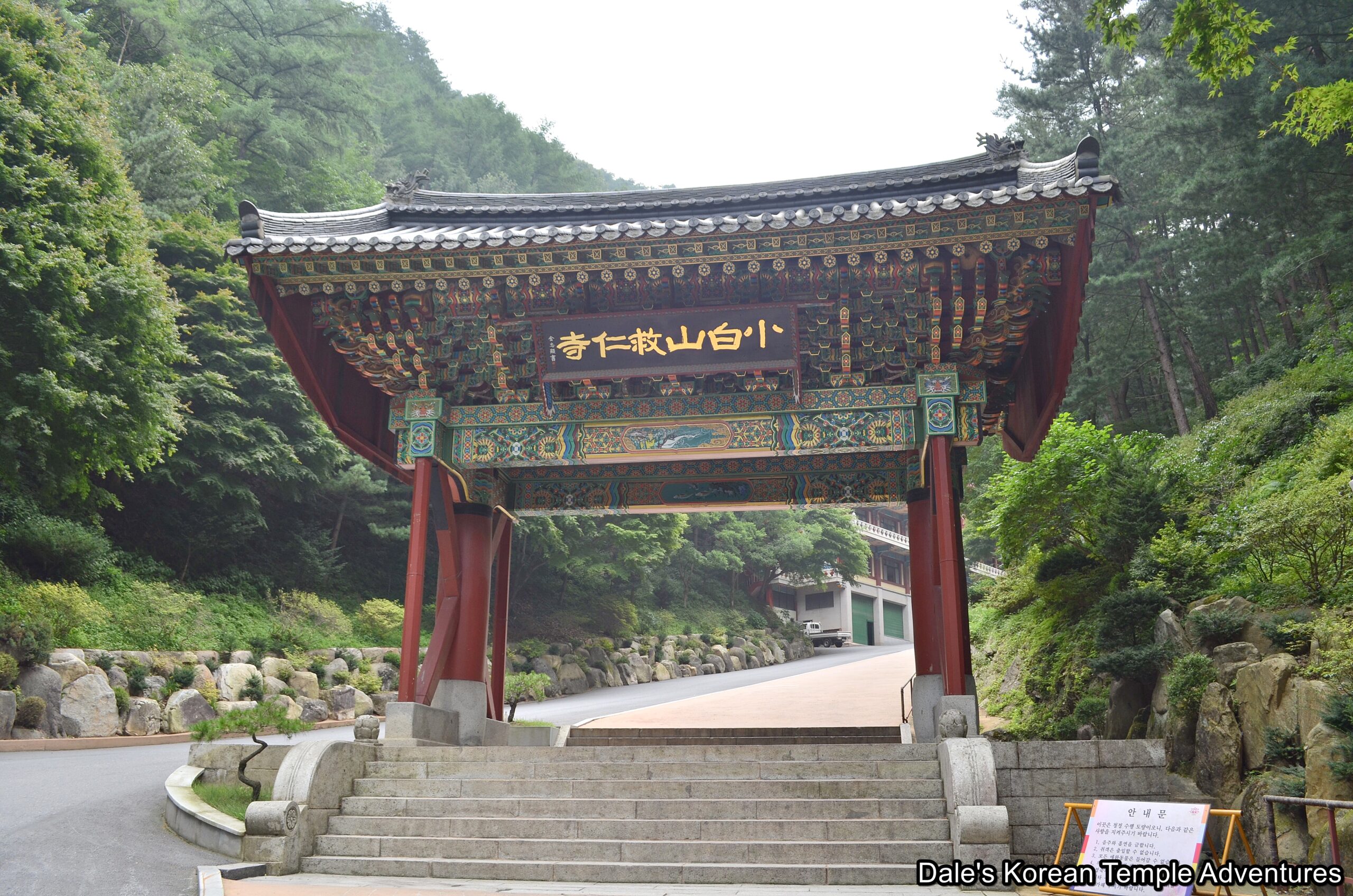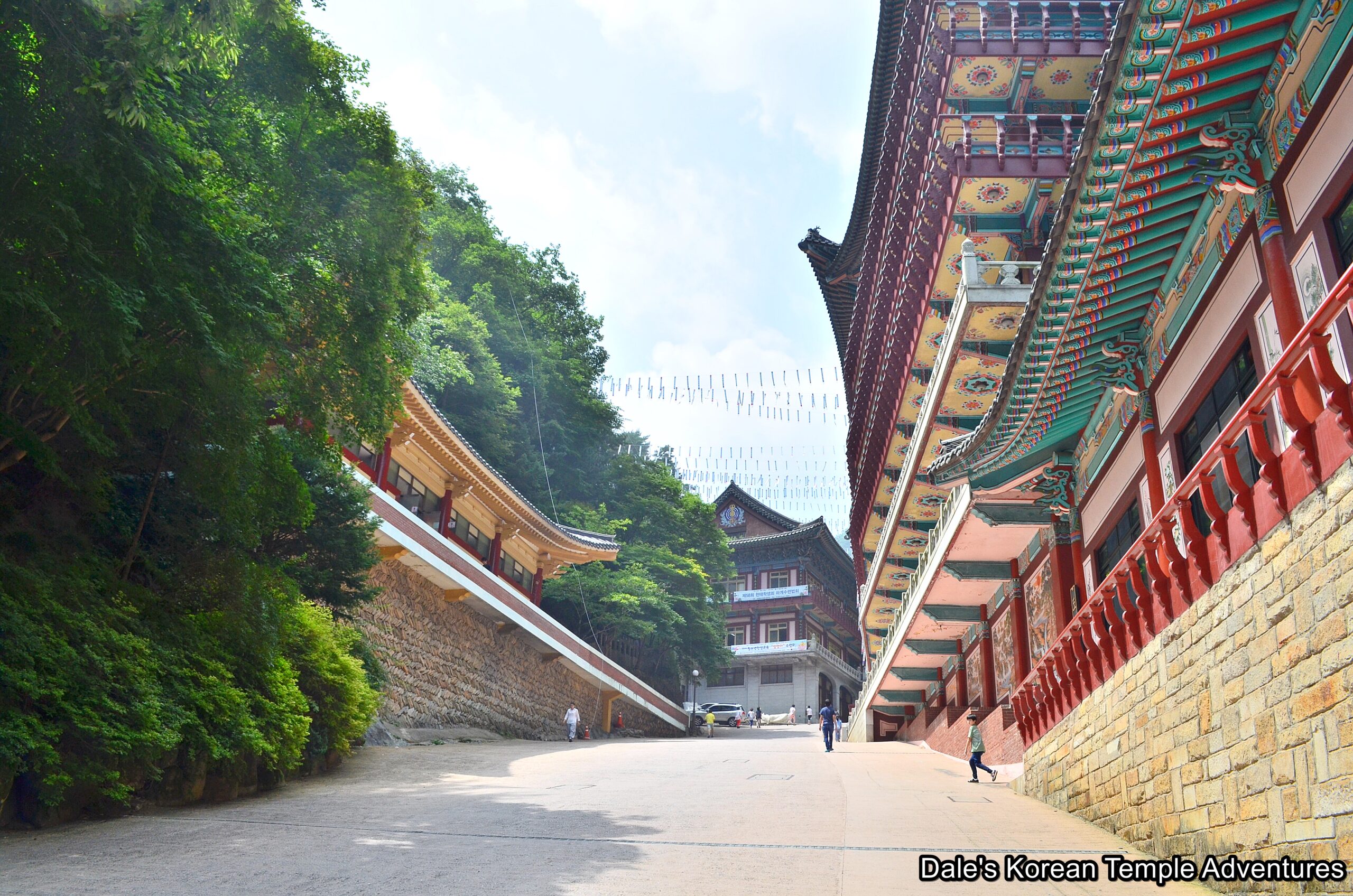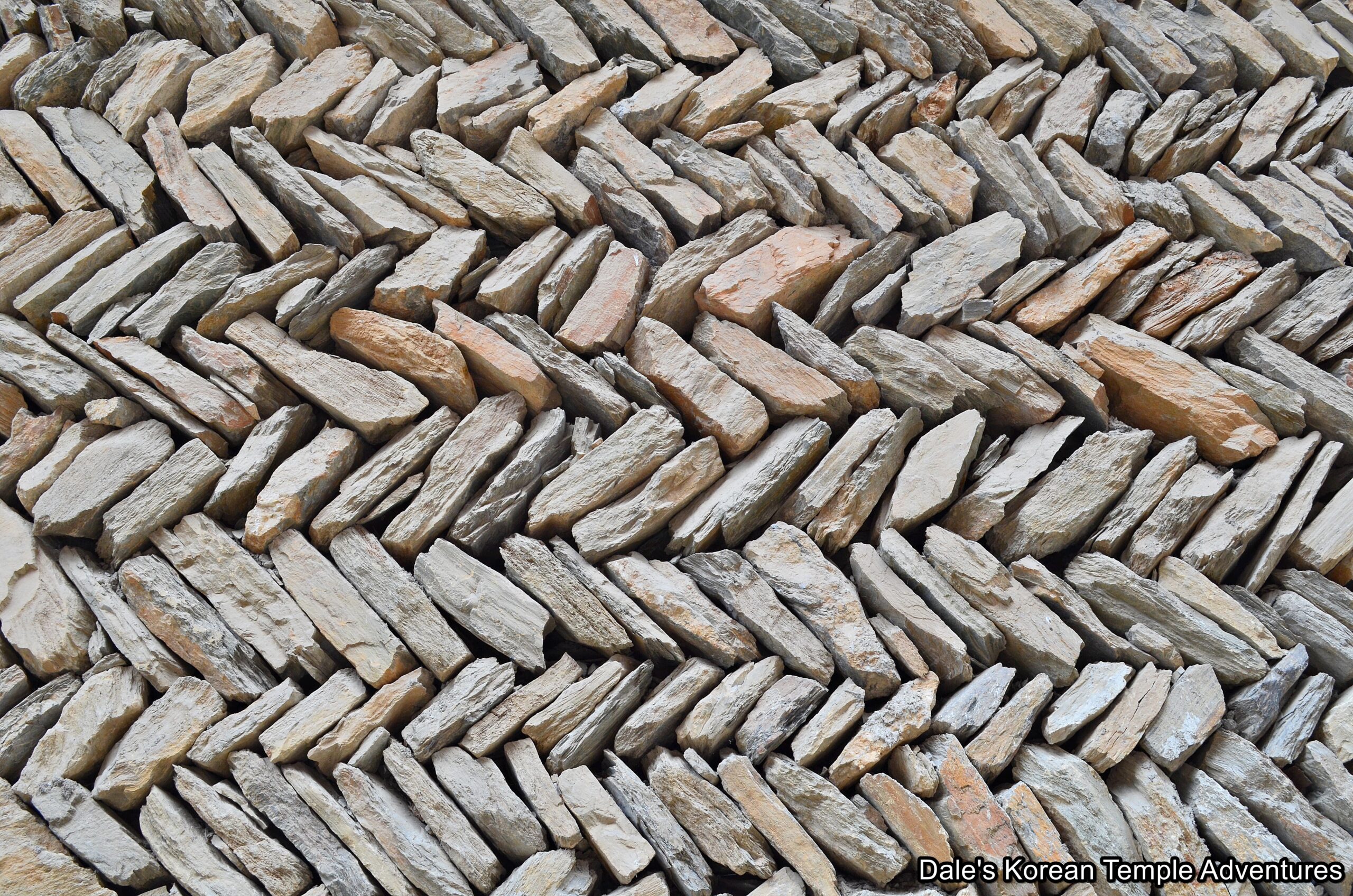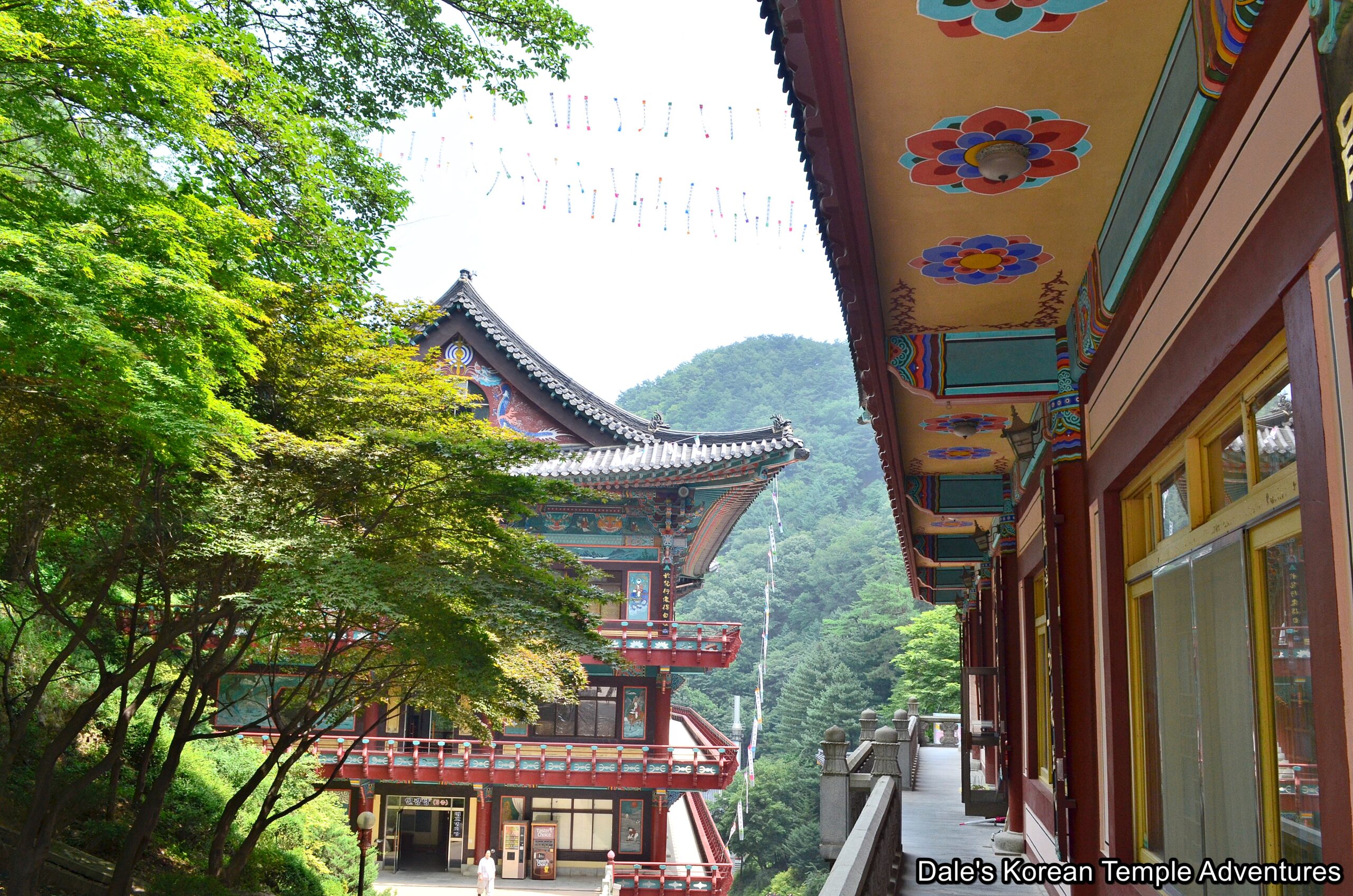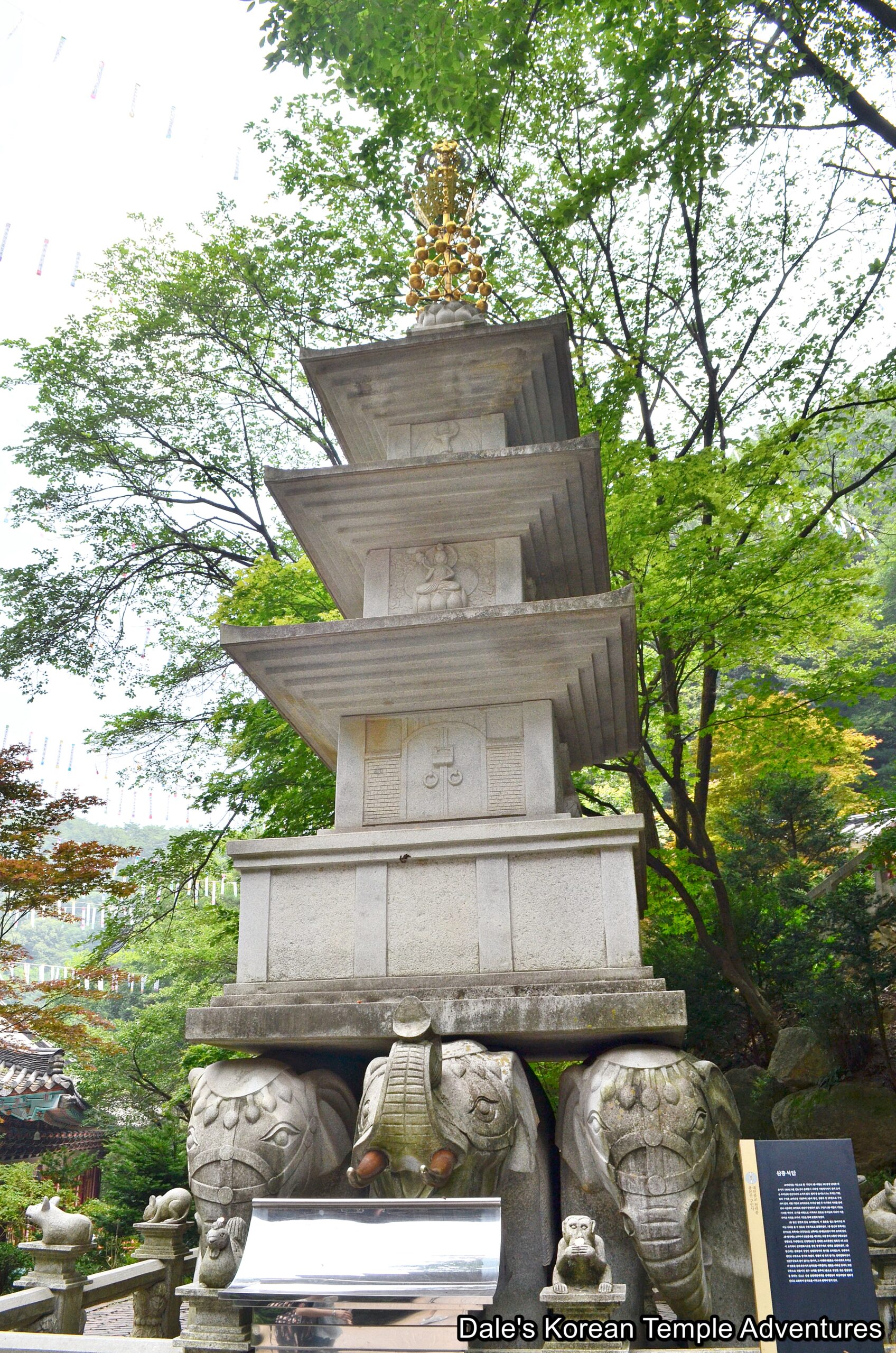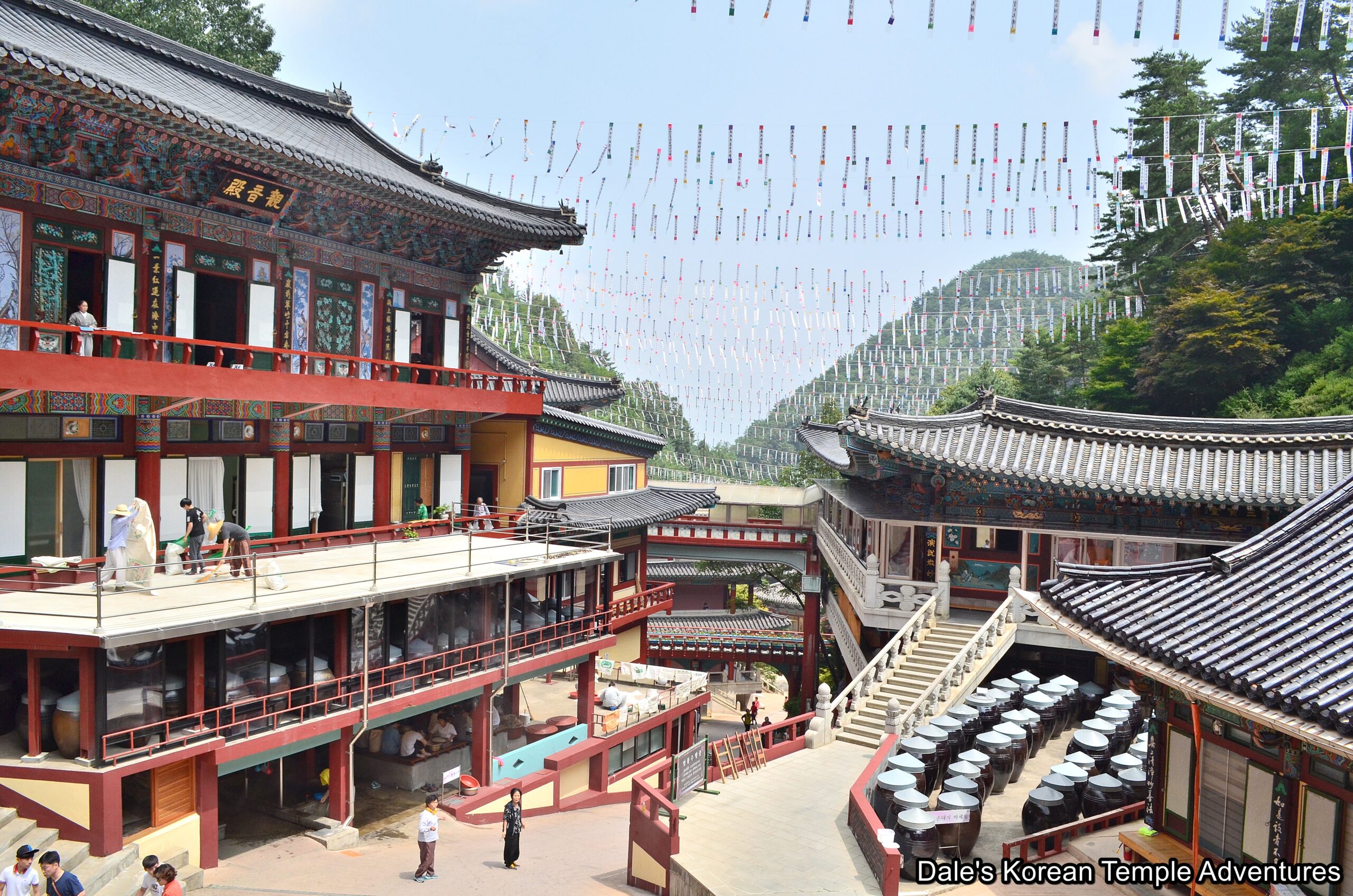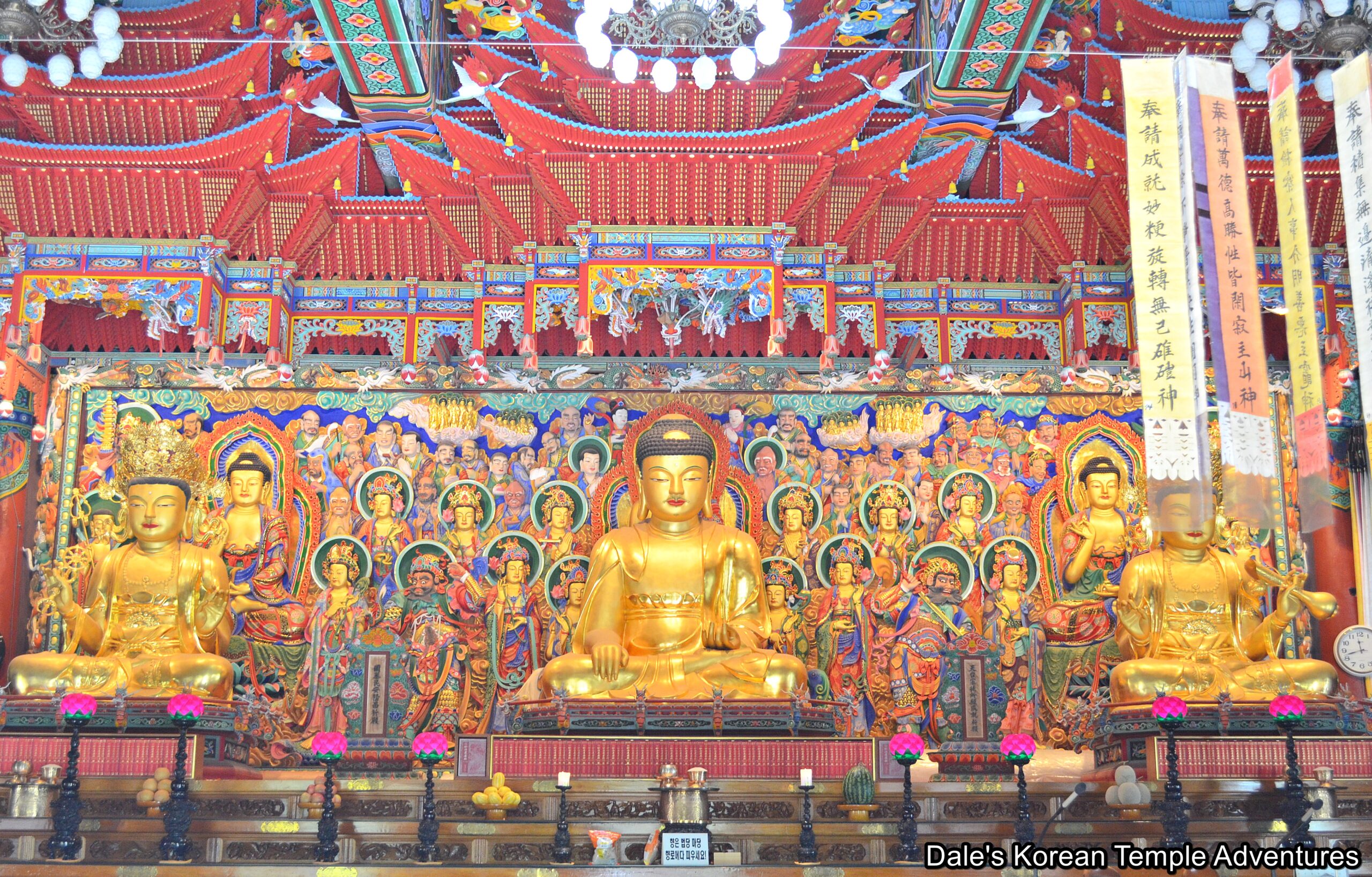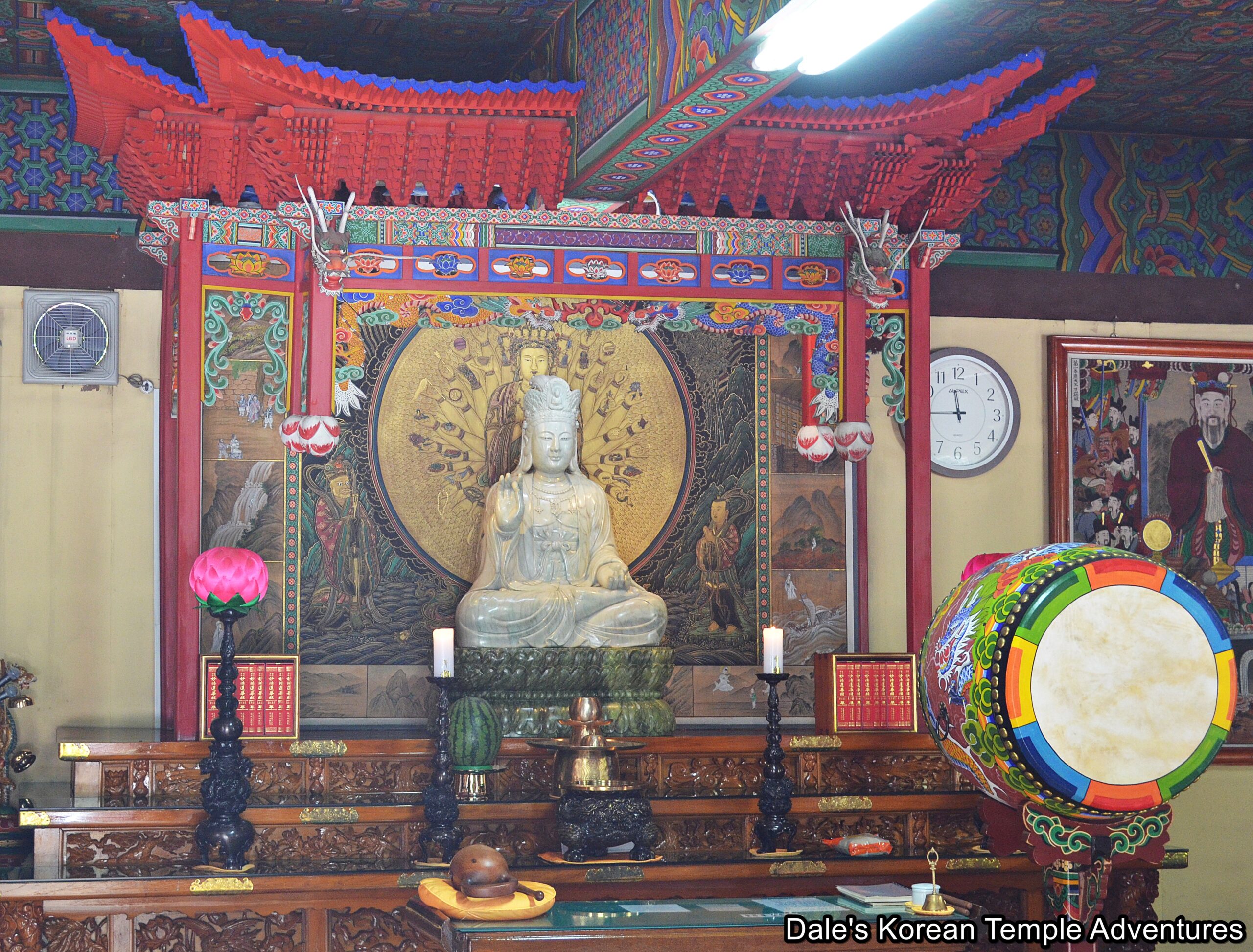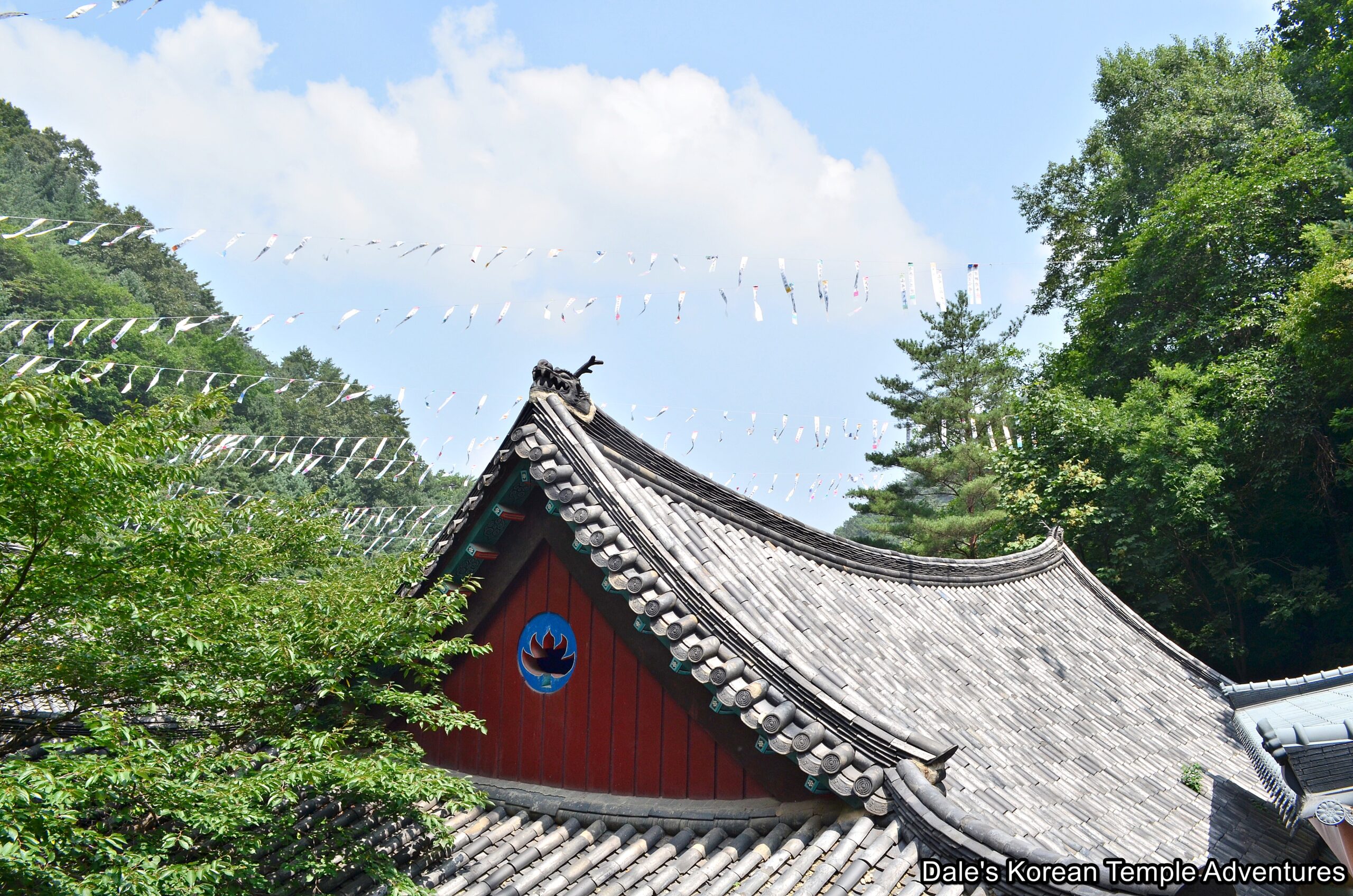Guinsa Temple – 구인사 (Danyang, Chungcheongbuk-do)
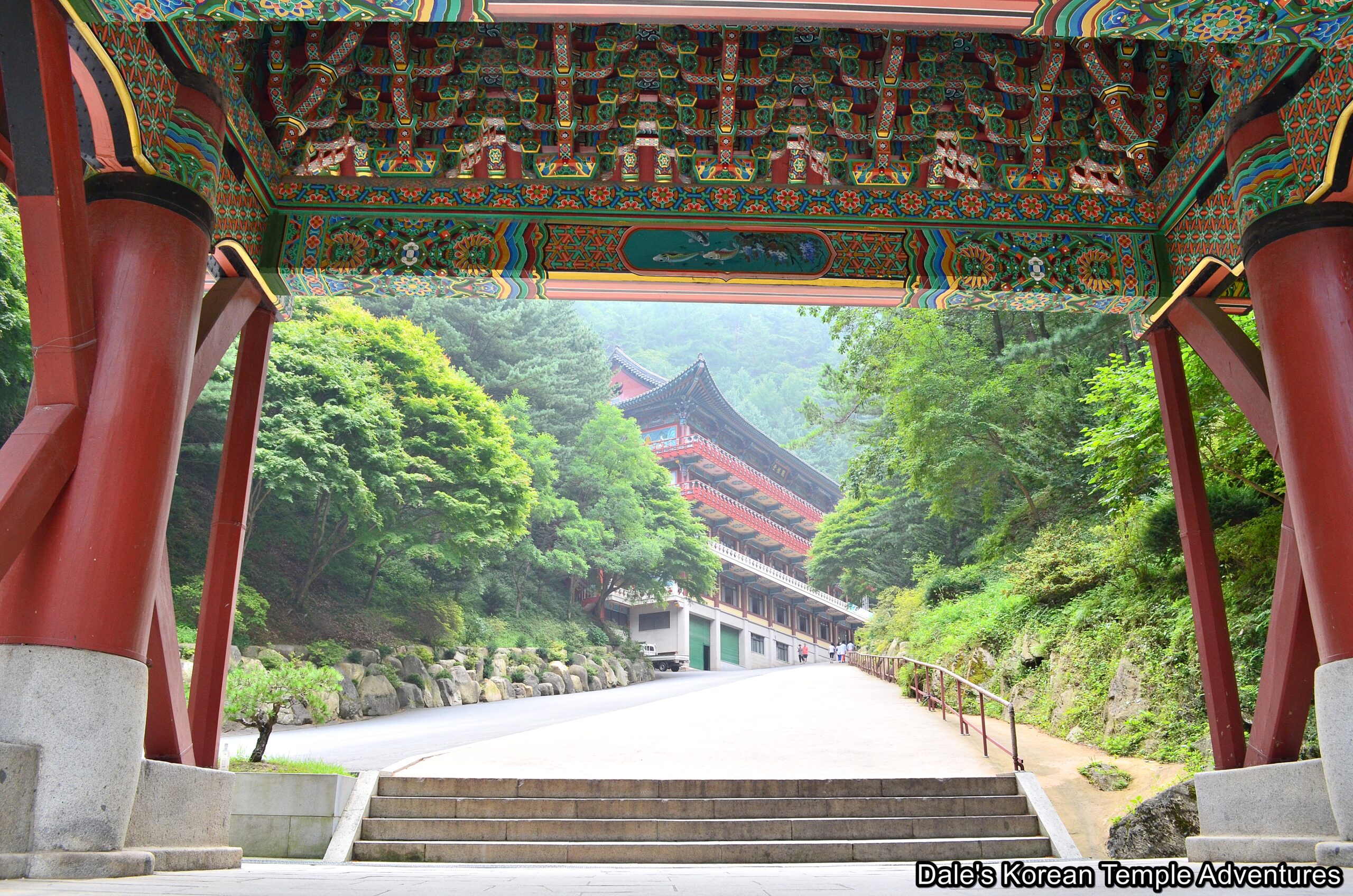
Temple History
Guinsa Temple, which means “Salvation of Humanity Temple,” in English is located in the Danyang, Chungcheongbuk-do. Guinsa Temple is situated up a long valley north of the towering Mt. Sobaeksan (1439.6m). The temple was first completed in 1945, when the contemporary founder of the Cheontae-jong Order, Sangwol-wongak, built a small hut from arrowroot vines. During his time here, he received a revelation about the truth of the universe, which is an interpretation of the Lotus Sutra. During the Korean War (1950-53), the temple was destroyed in the fighting. In 1966, Guinsa Temple was renovated and expanded. And in 1967, the Cheontae-jong Order was registered with the Korean government, officially re-establishing the Cheontae-jong school of Buddhist thought.
Cheontae is a descendent of the Chinese Buddhist school Tiantai. Cheontae was introduced a few times to the Korean peninsula from when it was first established in China in 594 A.D. by Master Zhiyi (or 지의, in Korean). Master Yeongwang, a Silla Kingdom monk, studied under Master Zhiyi in China from 581-597 A.D., but later returned to the Korean peninsula to teach the Cheontae teachings. Again in 730 A.D., the Silla monks Peopyung, Ieung, and Sunyeong studied the Cheontae teachings under the Master Monk Chwagye Hyeonrang. Later, they returned to Korea to transmit the Cheontae teachings. However, it wasn’t until the monk Uicheon (1055-1101), in 1086, who re-introduces the Cheontae teachings, that they finally take root. By re-introducing the Cheontae teachings, Uicheon was attempting to ease the tension between the doctrinal (Gyo) and Seon (Zen) schools of Buddhism. However, by 1424, Korean Cheontae Buddhism was absorbed by the Seon school of Buddhism as part of the anti-Buddhist policy during the Joseon Dynasty (1392-1910).
An interesting point is to be made about why Cheontae-jong temples differ in their ornateness from the more popular and austere Jogye-jong Order Temples. According to Cheontae doctrine, all sensory experiences of the world are in fact expressions of the Dharma. Therefore, these sensory experiences contain the key to potential enlightenment. That’s why Cheontae-jong Order temples like Guinsa Temple are far more colourful and elaborate than their Jogye-jong Order temple counterparts.
Guinsa Temple is the headquarters of the Cheontae-jong Order in Korea, which governs over 140 temples like and Samgwangsa Temple in Busan. Also, the Cheontae-jong Order has over two million adherents. In total, the temple is home to fifty buildings that include shrine halls, meeting centres, dorms, and administrative offices. The temple is so large that it can house up to 10,000 monks at any given time. Guinsa Temple also hosts the very popular Temple Stay program at its temple.
Temple Layout
You first approach the temple up a gradual incline that becomes a bit steeper near the outskirts of the temple grounds. The first structure to greet you is the stately Iljumun Gate, or “One Pillar Gate,” in English. Passing through the Iljumun Gate, you’ll notice a building that stacks up nicely against the slopes of the neighbouring mountain. Another thing to note about Guinsa Temple, and this very first temple building is a great indicator of this, is that unlike traditional temples, Guinsa Temple has multi-floored buildings. Perhaps out of a need to maximize space in the narrow valley fold, but Guinsa Temple doesn’t look like any other temple in Korea with its overstacked and layered appearance.
Next, you’ll approach a fortress-like gate that acts as the Cheonwangmun Gate. Housed on the second floor of this structure are some fierce-looking Four Heavenly Kings. Past this entry gate, and a collection of administrative buildings and dorms, you’ll finally come to the first structure at Guinsa Temple. The first structure is an elephant based three-story stone pagoda with three sari (crystallized remains) of the Buddha. They were brought to the temple from the Jetavana monastery in India.
To the right of this pagoda, and up a flight of stairs, is the temple’s Geukrak-jeon Hall. A beautiful collection of Shimu-do, or “Ox-Herding Murals,” in English, adorn the exterior walls to this hall. As for inside of this rather busy hall, you’ll find a triad of statues resting on the main altar. In the centre sits Amita-bul (The Buddha of the Western Paradise). This statue is joined on either side by Gwanseeum-bosal (The Bodhisattva of Compassion) and Daesaeji-bosal (The Bodhisattva of Power and Wisdom for Amita-bul). And just to the right of this hall is the temple’s elevated bell pavilion.
Just to the north of the Geukrak-jeon Hall is the Gwaneum-jeon Hall, which is beautifully painted on the exterior walls with the various incarnations of Gwanseeum-bosal. As for inside this hall, and seated on the main altar, is a jade statue of the Bodhisattva of Compassion. She is backed by a beautiful multi-armed mural of herself. It’s also from the Gwaneum-jeon Hall that you can get some great pictures of the Guinsa Temple grounds.
Just a little further up the mountain, and you’ll come to the massive five-story modern main hall. Inside, you’ll find an equally massive statue of Seokgamoni-bul (The Historical Buddha) sitting on the main altar. This statue of the Buddha is backed by a stunning Vulture Peak relief.
And just to the left of the main hall is the Nahan-jeon Hall, which is golden in colour and somewhat Chinese influenced in design. Inside this hall are a masterful collection of Nahan (The Disciples of the Historical Buddha) statues. And to the right of the main hall, and up yet another flight of stairs (trust me, you’ll get your fill of them at this temple) is the crowning Daejosa-jeon Hall, or “The Great Founders Hall,” in English. This golden three-story shrine hall is fronted by a pair of protective Vajra warriors. As for inside this hall, you’ll find sitting on the main altar a golden statue of the First Patriarch of the modern Cheontae-jong Order: Sangwon-wongsa.
Admission to the temple is free.
How To Get There
To get to Guinsa Temple, you’ll first need to get to the Danyang Intercity Bus Terminal. From this terminal, you’ll need to board a bus bound for Guinsa Temple. The first bus for Guinsa Temple leaves at 9:20 a.m., and the last bus leaves at 8:20 p.m. This bus leaves every hour.
Overall Rating: 7.5/10
To be honest, I definitely have mixed feelings about Guinsa Temple. While it definitely has a lot of highlights like the elephant based pagoda that contains the sari of the Buddha, the Gwaneum-jeon Hall, the Nahan-jeon Hall, and the Daejosa-jeon Hall, all the buildings at Guinsa Temple are made of concrete (which is a bit of a hang-up for a traditionalist like me). Also, all the buildings at Guinsa Temple are squeezed together in a towering line that blots out the neighbouring mountain. So this temple, at least for me, is a bit of a mixed bag and the overall rating I give this temple reflects that. While great for some, it just wasn’t quite what I was expecting when first visiting Guinsa Temple.
